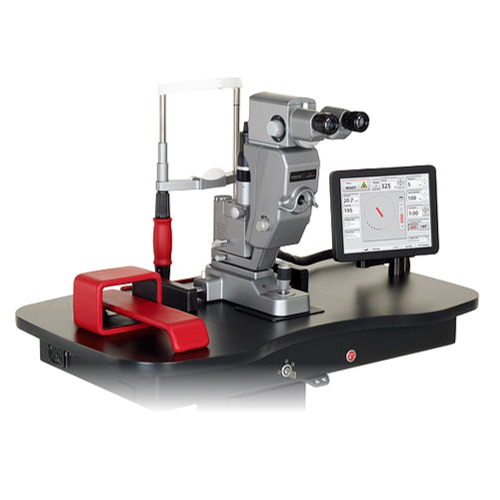
LASER PASCAL STREAM LINE 577
Photocoagulation, trabeculoplasty, conjuctival laser and eyelash laser
The PASCAL (pattern scanning laser) photocoagulator is a fully integrated photocoagulation laser scanning system designed for the treatment of diabetic retinopathy using one shot or a certain pattern of up to 25 points. Created to set a new standard for the treatment of retinal diseases, Pascal has been used to treat thousands of patients around the world. It features an intuitive touch screen and an advanced optical slit lamp.
Photocoagulation is a technique that generates a scar on the retina through a therapeutic burn, for which a beam of light (laser) is applied to it. The resulting scar makes it possible to stop the development of certain retinal diseases. Photocoagulation can stimulate healing and thus increase the adhesion of the retina to the eye wall (for example, in retinal tears and retinal detachment), control ischemic areas in the retina in which there is a lack of oxygen , eliminate exudative areas (with abnormal deposits and fluids) and control proliferative or tumorous areas. It is used for the treatment of retinal tears, vascular rhinopathies, it reduces eye pressure by facilitating the outflow of aqueous humor in cases of glaucoma, as well as the treatment of tumors by helping to stop the growth or reduce retinal tumors.
Trabeculoplasty is a procedure performed with an argon laser. It consists of applying the laser directly to the filtration area of the eye, the trabeculum, in order to increase the outflow of aqueous humor and, thus, reduce intraocular pressure. This technique is indicated when drops (hypotensive eye drops) do not achieve an effective reduction in intraocular pressure and the patient is not a candidate for surgery, either because the glaucoma is not sufficiently advanced or because the operation may pose a great risk to his or her condition. health. For its application, it is necessary to meet a series of requirements: open angle and sufficiently pigmented.
The conjunctiva is the outermost layer of the eye. Its function is protection, being the first to be affected by external agents such as dust and solar radiation. When these elements combine in a susceptible patient, there is a high probability of developing “fleshes” ( pterygium) in the eyes which are an abnormal growth of the conjunctiva that, although not malignant, can be very annoying, generating ocular itching, a sensation of a foreign body and redness of the eye. Once the pterygium appears, the most common solution is surgery. There are multiple techniques that allow the removal of fleshiness with quite acceptable success rates; however, when the lesion is detected early and has certain structural characteristics, pterygium surgery could be replaced by laser treatment. To treat fleshiness with laser, these should not be very extensive, ideally they should be flat and not extend beyond the sclero-corneal limbus; If all these conditions are met, the patient is a candidate for resolution by laser on the ocular surface.
Trichiasis is an eyelid problem that can seriously affect a person's eye health. The problem is generated because one or more eyelashes grow into the eye, causing constant friction that is annoying and can cause injuries to the surface of the cornea. Treatment of trichiasis seeks to eliminate abnormal eyelash hair follicles. Although the treatment of trichiasis seems simple, there is no completely effective technique. There are several treatment possibilities depending on the cause, the extent of trichiasis and the condition of the eyelids: periodic hair removal of the eyelashes, cauterization of the eyelashes with an Argon laser, cryocoagulation or surgical treatment. Treatment by photocoagulation with Argon laser or cryotherapy is only effective when the eyelashes in the wrong direction are not very numerous.
